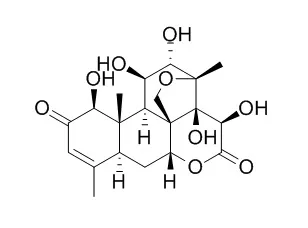| Int J Mol Med. 2012 Jul;30(1):93-9. |
| Involvement of the mitochondrial pathway in bruceine D-induced apoptosis in Capan-2 human pancreatic adenocarcinoma cells.[Pubmed: 22552257] |
Our research group has previously identified Bruceine D (BD), a quassinoid found abundantly in B. javanica, to have potent cytotoxic effect on a number of pancreatic cancer cell lines, including Panc-1, SW1990 and Capan-1 cells.
METHODS AND RESULTS:
In the present study, we showed that Bruceine D was also able to inhibit the growth of the Capan-2 human pancreatic adenocarcinoma cell line, but it exerted only modest cytotoxicity on the WRL68 human hepatocyte cell line and a human pancreatic progenitor cell line. The antiproliferative effects of Bruceine D were comparable to those exhibited by camptothecin and gemcitabine in our culture system. We found a dose-dependent decrease of the mitochondrial membrane potential in Bruceine D-treated Capan-2 cells as measured by the JC-1 assay. Bruceine D exposure was able to attenuate the expression of Bcl-2 protein in Capan-2 cells as detected by western blot analysis. In addition, the expression of both caspase 9 and caspase 3 in Bruceine D-treated Capan-2 cells was significantly accentuated. Moreover, Bruceine D was capable of inducing the fragmentation of genomic DNA in Capan-2 cells as evidenced by Hoechst staining. Cell cycle analysis demonstrated that Bruceine D could increase the percentage of Capan-2 cells in the subG1 phase in a dose-related manner. An increase in the apoptosis of Capan-2 cells was also observed by Annexin V and PI staining.
CONCLUSIONS:
These results unequivocally indicate that Bruceine D induces cytotoxicity in Capan-2 cells via the induction of cellular apoptosis involving the mitochondrial pathway. |
| Vet Parasitol. 2011 Apr 19;177(1-2):127-33. |
| In vivo anthelmintic activity of bruceine A and bruceine D from Brucea javanica against Dactylogyrus intermedius (Monogenea) in goldfish (Carassius auratus).[Pubmed: 21196080] |
The present study was designated to ascertain the anthelmintic activity of the dried fruits of Brucea javanica and to isolate and characterise the active constituents. The methanol extract from the fruits of B. javanica showed significant anthelmintic activity against Dactylogyrus intermedius (EC(50) (median effective concentration) value=49.96 mg l(-1)).
METHODS AND RESULTS:
Based on this finding, the methanol extract was fractionated on silica gel column chromatography in a bioassay-guided fractionation affording two known quassinoids showing potent activity, bruceine A and Bruceine D. Both bruceine A and D exhibited significant activity against D. intermedius with EC(50) values of 0.49 mg l(-1) and 0.57 mg l(-1), respectively, which were more effective than the positive control, mebendazole (EC(50) value=1.25 mg l(-1)). In addition, the 48-h median lethal concentration (LC(50)) for bruceine A and D against the host (Carassius auratus) was 10.6-fold and 9.7-fold higher than the EC(50) for D. intermedius.
CONCLUSIONS:
These results provide evidence that the isolated compounds might be potential sources of new anti-parasitic drugs for the control of Dactylogyrus. This is the first report on an in vivo anthelmintic investigation for B. javanica against D. intermedius. |
| Pest Manag Sci. 2008 Feb;64(2):191-6. |
| Antiphytoviral activity of bruceine-D from Brucea javanica seeds.[Pubmed: 17912689 ] |
Brucea javanica (L.) Merr. is widely distributed throughout the southern parts of China and has been used in traditional medicine to treat a variety of diseases. The objective of the present study was to identify the active antiphytoviral compound in the seeds of B. javanica and evaluate the inhibitory activity of the compound against plant virus.
METHODS AND RESULTS:
Bioassay-guided fractionation of the most active extract from the seeds led to the isolation of an antiphytoviral compound which was identified as bruceine-D by conventional spectroscopy methods. The compound exhibited significant inhibitory activity against the infection and replication of tobacco mosaic virus (TMV), with IC(50) values of 13.98 and 7.13 mg L(-1) respectively. The compound also showed a strong inhibitory effect on the infectivity of potato virus Y (PVY) and cucumber mosaic virus (CMV). Furthermore, the compound could effectively inhibit systemic TMV infection in the host tobacco plant under glasshouse conditions.
CONCLUSIONS:
The results suggested that bruceine-D from Brucea javanica may have the potential to be used as a natural viricide, or a lead compound for new viricides. |
| J Agric Food Chem . 2019 Apr 17;67(15):4232-4239. |
| Bruceine D Isolated from Brucea Javanica (L.) Merr. as a Systemic Feeding Deterrent for Three Major Lepidopteran Pests[Pubmed: 30901209] |
| Abstract
Systemicity is a desirable property for insecticides. Many phytochemicals show good systemic properties and thus are natural sources of novel systemic insecticidal ingredients. Bruceine D, a quassinoid, was identified in Brucea javanica (L.) Merr. and displayed outstanding systemic properties and excellent antifeedant activity against the diamondback moth (DBM, Plutella xylostella L.), beet armyworm ( Spodoptera exigua Hübner), and cotton leafworm ( Spodoptera litura Fabricius). Its antifeedant effect on third instar larvae of DBM was approximately 6.2-fold stronger than that of azadirachtin. When Bruceine D was applied to roots at a concentration of 100 μg/mL for 24 and 48 h, its concentration in flowering Chinese cabbage ( Brassica campestris L. ssp. chinensis var. utiliz Tsen et Lee) leaves was 38.69 μg/g (fresh weight, FW) and 108.45 μg/g (FW), respectively. These concentrations could achieve 93.80% and 96.83% antifeedant effects, which were significantly greater than those of azadirachtin. Similar to azadirachtin, Bruceine D also posed a potent growth inhibition effect on insect larvae. After feeding with 20 μg/g Bruceine D, no pupae were observed. The results demonstrated that Bruceine D is an effective botanical insect antifeedant with outstanding systemic properties, causing potent pest growth inhibitory activity.
Keywords: Plutella xylostella; Spodoptera exigua; Spodoptera litura; botanical insecticide; Bruceine D; insect antifeedant; systemicity. |






 Cell. 2018 Jan 11;172(1-2):249-261.e12. doi: 10.1016/j.cell.2017.12.019.IF=36.216(2019)
Cell. 2018 Jan 11;172(1-2):249-261.e12. doi: 10.1016/j.cell.2017.12.019.IF=36.216(2019) Cell Metab. 2020 Mar 3;31(3):534-548.e5. doi: 10.1016/j.cmet.2020.01.002.IF=22.415(2019)
Cell Metab. 2020 Mar 3;31(3):534-548.e5. doi: 10.1016/j.cmet.2020.01.002.IF=22.415(2019) Mol Cell. 2017 Nov 16;68(4):673-685.e6. doi: 10.1016/j.molcel.2017.10.022.IF=14.548(2019)
Mol Cell. 2017 Nov 16;68(4):673-685.e6. doi: 10.1016/j.molcel.2017.10.022.IF=14.548(2019)